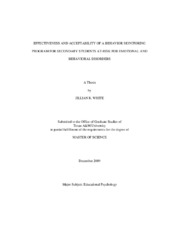| dc.contributor.advisor | Burke, Mack | |
| dc.creator | White, Jillian R. | |
| dc.date.accessioned | 2011-02-22T22:24:06Z | |
| dc.date.accessioned | 2011-02-22T23:47:27Z | |
| dc.date.available | 2011-02-22T22:24:06Z | |
| dc.date.available | 2011-02-22T23:47:27Z | |
| dc.date.created | 2009-12 | |
| dc.date.issued | 2011-02-22 | |
| dc.date.submitted | December 2009 | |
| dc.identifier.uri | https://hdl.handle.net/1969.1/ETD-TAMU-2009-12-7525 | |
| dc.description.abstract | Schools are facing an increasing pressure to deal effectively with students' problem behaviors in the school environment. Research suggests that Behavior Monitoring Programs (BMPs) are effective and efficient secondary interventions to use in remedying problem behavior in the classroom and are acceptable to teachers, parents, and students. Most of the research on BMPs has been conducted at the elementary school level. The current study investigated the effectiveness of a BMP within a school-wide system of Positive Behavior Support (PBS) with three suburban high school students.
Problem behaviors for each student were targeted based upon previous office discipline referral data (ODR) and teacher comments, and three behavioral goals were made for students based upon these findings, along with teacher input. Effectiveness of the intervention was measured by the increase in teacher's behavioral ratings on the Daily Behavior Report Card (DBRC). Furthermore, teachers, parents and students rated the intervention's effectiveness via a five-item intervention acceptability questionnaire.
Results of the study suggest that the BMP intervention is both effective and acceptable for use with secondary students. All students experienced an increase in behavioral ratings on the DBRC during intervention. Across all students and all behaviors, the intervention resulted in an overall mean improvement of 63% in problem behaviors in the classroom. Average effect sizes were large while probability levels were low. Furthermore, all teachers, parents, and students rated the intervention as being acceptable. The average rating that all parents gave for all five items (on a 6 point scale with higher numbers indicating greater acceptability) was 5.2, while the average for students was 4.3. The student's teachers together rated all five items as 4.8. | en |
| dc.format.mimetype | application/pdf | |
| dc.language.iso | en_US | |
| dc.subject | high school students and problem behavior | en |
| dc.subject | interventions for problem behaviors | en |
| dc.subject | Interventions for secondary students | en |
| dc.subject | Behavior Monitoring Program | en |
| dc.subject | behavior interventions | en |
| dc.subject | behavior modification | en |
| dc.subject | Behavior Education Program | en |
| dc.title | Effectiveness and Acceptability of a Behavior Monitoring Program for Secondary Students At-risk for Emotional and Behavioral Disorders | en |
| dc.type | Book | en |
| dc.type | Thesis | en |
| thesis.degree.department | Educational Psychology | en |
| thesis.degree.discipline | Educational Psychology | en |
| thesis.degree.grantor | Texas A&M University | en |
| thesis.degree.name | Master of Science | en |
| thesis.degree.level | Masters | en |
| dc.contributor.committeeMember | Rackley, Robin | |
| dc.contributor.committeeMember | Vannest, Kimberly | |
| dc.type.genre | Electronic Thesis | en |
| dc.type.material | text | en |


